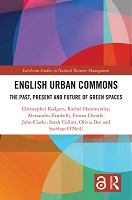English Urban Commons
Proposal review
The Past, Present and Future of Green Spaces
| dc.contributor.author | Rodgers, Christopher | |
| dc.contributor.author | Hammersley, Rachel | |
| dc.contributor.author | Zambelli, Alessandro | |
| dc.contributor.author | Cheatle, Emma | |
| dc.contributor.author | Clarke, John | |
| dc.contributor.author | Collins, Sarah | |
| dc.contributor.author | Dee, Olivia | |
| dc.contributor.author | O’Neill, Siobhan | |
| dc.date.accessioned | 2023-11-14T15:03:24Z | |
| dc.date.available | 2023-11-14T15:03:24Z | |
| dc.date.issued | 2024 | |
| dc.identifier | OCN: 1409541073 | |
| dc.identifier.uri | https://library.oapen.org/handle/20.500.12657/85120 | |
| dc.description.abstract | The book presents a novel examination of urban commons which provides a robust base for education initiatives and future public policy guidance on the protection and use of urban commons as invaluable urban green spaces that offer a diverse cultural and ecological resource for future communities. The book's central argument is that only through a deep understanding of the past and a rigorous engagement with present users, can we devise new futures or imaginaries of culture, well-being and diversity for the urban commons. It argues that understanding the genesis of, and interactions between, the different pressures on urban green space has important policy implications for the delivery of nature conservation, recreational access and other land use priorities. The stakeholders in today’s urban commons, whether land users, policy makers or the public, are the inheritors of a complex cultural legacy and must negotiate diverse and sometimes conflicting objectives in their pursuit of a potentially unifying goal: a secure future for our urban commons. The book offers a unique and strongly interdisciplinary study of urban commons, one that brings together original historical investigation, contemporary legal scholarship, extensive oral history research with user groups, and research examining the imagined futures for the urban common in modern society. It explores the complex social and political history of the urban common, as well as its legal and cultural status today, using four diverse case studies from within England as exemplars of the distinctively urban common. These are Town Moor in Newcastle, Mousehold Heath in Norwich, Clifton and Durdham Downs in Bristol and Valley Gardens in Brighton. The book concludes by looking forward and considering new tools and methods of negotiation, inclusivity and creativity to inform the future of these case studies, and of urban commons more widely. This book will be of great interest to students and scholars of the commons, green spaces, urban planning, environmental and urban geography, environmental studies and natural resource management. | en_US |
| dc.language | English | en_US |
| dc.relation.ispartofseries | Earthscan Studies in Natural Resource Management | en_US |
| dc.subject.other | commons;culture;England;ecology;green;history;past;present;urban | en_US |
| dc.title | English Urban Commons | en_US |
| dc.title.alternative | The Past, Present and Future of Green Spaces | en_US |
| dc.type | book | |
| oapen.identifier.doi | 10.4324/9781003204558 | en_US |
| oapen.relation.isPublishedBy | 7b3c7b10-5b1e-40b3-860e-c6dd5197f0bb | en_US |
| oapen.relation.isFundedBy | f5575346-ce3d-4ecc-aca8-5fee7c6be5cb | en_US |
| oapen.relation.isbn | 9781003204558 | en_US |
| oapen.relation.isbn | 9781032069180 | en_US |
| oapen.relation.isbn | 9781032069210 | en_US |
| oapen.imprint | Routledge | en_US |
| oapen.pages | 265 | en_US |
| peerreview.anonymity | Single-anonymised | |
| peerreview.id | bc80075c-96cc-4740-a9f3-a234bc2598f1 | |
| peerreview.open.review | No | |
| peerreview.publish.responsibility | Publisher | |
| peerreview.review.stage | Pre-publication | |
| peerreview.review.type | Proposal | |
| peerreview.reviewer.type | Internal editor | |
| peerreview.reviewer.type | External peer reviewer | |
| peerreview.title | Proposal review | |
| oapen.review.comments | Taylor & Francis open access titles are reviewed as a minimum at proposal stage by at least two external peer reviewers and an internal editor (additional reviews may be sought and additional content reviewed as required). |

